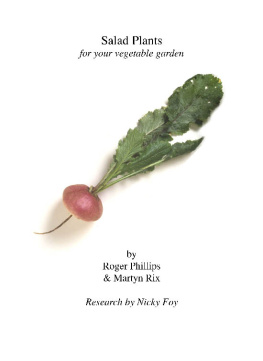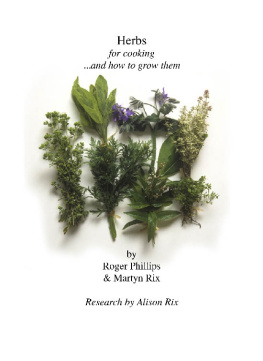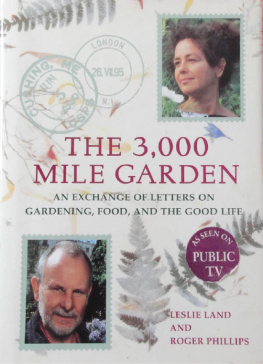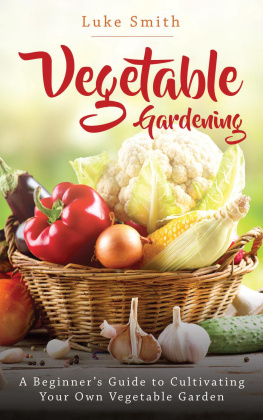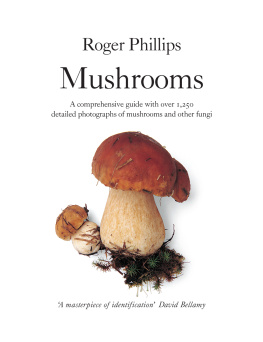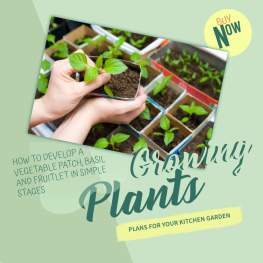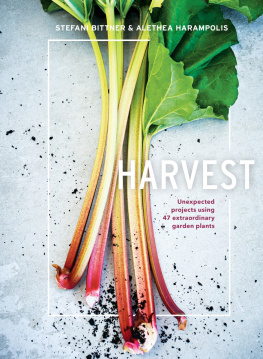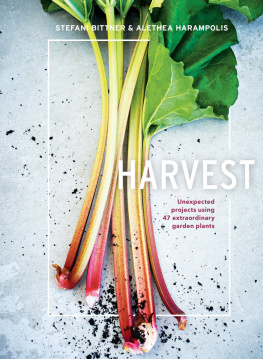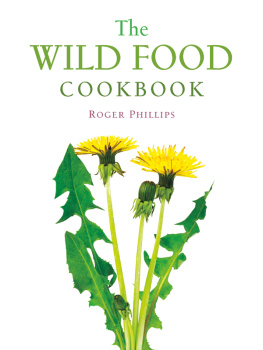Phillips Roger - Salad plants for your vegetable garden
Here you can read online Phillips Roger - Salad plants for your vegetable garden full text of the book (entire story) in english for free. Download pdf and epub, get meaning, cover and reviews about this ebook. City: London, year: 2010, publisher: Roger Phillips, genre: Children. Description of the work, (preface) as well as reviews are available. Best literature library LitArk.com created for fans of good reading and offers a wide selection of genres:
Romance novel
Science fiction
Adventure
Detective
Science
History
Home and family
Prose
Art
Politics
Computer
Non-fiction
Religion
Business
Children
Humor
Choose a favorite category and find really read worthwhile books. Enjoy immersion in the world of imagination, feel the emotions of the characters or learn something new for yourself, make an fascinating discovery.
- Book:Salad plants for your vegetable garden
- Author:
- Publisher:Roger Phillips
- Genre:
- Year:2010
- City:London
- Rating:3 / 5
- Favourites:Add to favourites
- Your mark:
- 60
- 1
- 2
- 3
- 4
- 5
Salad plants for your vegetable garden: summary, description and annotation
We offer to read an annotation, description, summary or preface (depends on what the author of the book "Salad plants for your vegetable garden" wrote himself). If you haven't found the necessary information about the book — write in the comments, we will try to find it.
Salad plants for your vegetable garden — read online for free the complete book (whole text) full work
Below is the text of the book, divided by pages. System saving the place of the last page read, allows you to conveniently read the book "Salad plants for your vegetable garden" online for free, without having to search again every time where you left off. Put a bookmark, and you can go to the page where you finished reading at any time.
Font size:
Interval:
Bookmark:
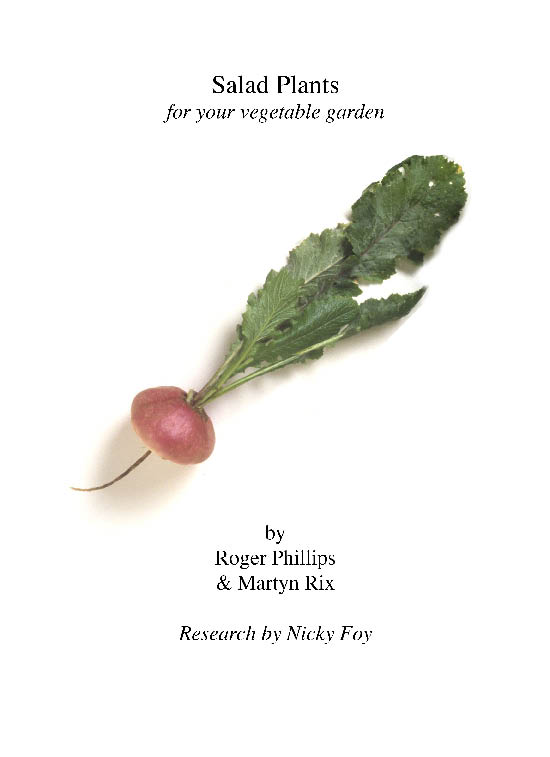
Acknowledgements
We would like to thank the following gardens and suppliers for allowing us to visit them and photograph their plants:
The Royal Horticultural Societys garden at Wisley for numerous specimens from the model vegetable garden; Barnsley House; Ryton Organic Garden; NIAB, Cambridge; Sandling Park; The Ballymaloe Cookery School Garden; Leiden Botanic Garden; Villandry; Green Gulch Farm, California.
Special thanks to Gill Stokoe, Jill Bryan & Debby Curry
The following also helped us by allowing us to take photographs in their gardens, and in other ways: Rosemary Verey, Joy Larkcom, Marilyn Inglis, Colin Martin, Anne Thatcher, Leslie Land and Anthony Rix.
Copyright in the text and illustrations
Roger Phillips and Martyn Rix
The right of the authors to be identified as the authors
of this work has been asserted by them in accordance with the Copyright, Designs and Patents Act 1988.
All rights reserved.
No reproduction, copy or transmission of this publication may be reproduced, copied or transmitted save with written permission or in accordance with the provisions of the Copyright Act 1956 (as amended). Any person who does any unauthorized act in relation to this publication may be liable to criminal prosecution and civil claims for damages.
Contents
Introduction
It used to be that the word salad conjured up three images: tomato, lettuce and cucumber, at least in Britain, Europe and much of North America. But over the last 1015 years the notion of what constitutes a salad has changed dramatically. No longer does salad mean a few wilting lettuce leaves adorned with some slices of tomato and cucumber; nowadays it means as wide a variety of vegetables as one has the imagination and creativity to combine together. Herbs, spices and salad greens from all over the world are now widely available and with them has come a host of new ideas about how to put them together in interesting and delicious combinations.
The purpose of this book is to present the keen amateur gardener-cum-gourmet with an interesting and fairly comprehensive selection of salad plants that can quite easily be grown in the garden and herb garden or, in many cases, in pots or on windowsills. We have tried to include most of the traditional favourite salad plants such as tomatoes and carrots, lettuces and spring onions but we have also included many plants that have only become internationally fashionable in the last decade or so, such as rocket, Chinese spinach, coriander and the edible flowers.
The Text
The plants are divided into five sections: leaves, roots and sprouts, fruits and beans, herbs and flowers although there is, of course, some overlap where, for example, both the young leaves of a plant and its roots can be eaten, such as celery, or flowers and young fruit as in courgettes. We have attempted to keep the text simple, avoiding complicated botanical or horticultural terms if possible. Each entry gives the main facts about the plant and, in the Planting Help, advice on how to grow it.
Growing Salad Plants
There are no hard and fast rules about growing salad plants except perhaps that they always need to have plenty of water if they are to thrive. The plants in this book have basically been selected with gardeners throughout northern Europe and North America in mind. However, differences in climate will mean that there will be slightly different requirements with regard to protection from extremes of temperature, time of sowing, harvesting and so on. For this reason we have not given temperature zones to individual plants. The general principle is that many salads will overwinter in mild climates (US zones 711) and many, such as lettuces, may grow better through the mild days from autumn to spring, whereas in colder climates the same varieties can be grown through the summer.
This book does not set out to be a manual for the cultivation of salad plants but we have provided brief notes on cultivation, mainly based on our own experience, which should be enough for amateurs to grow a reasonable crop. Different plants require and use up different nutrients; however the use of ample organic manure is fundamental to the success of most salad plants and especially those grown on sandy or clay soils. Organic matter provides food for plants, especially nitrogen and phosphate; it improves sandy and light, chalky soils, because the humus holds more water and makes clay soils more easily workable. Organic matter for vegetables is traditionally provided by mixing cow manure with straw, but household and garden compost heaps are other good sources of humus and plant food, as are horse manure and leaf mould. Compost-making bins are useful for making small amounts of compost in a short time.
Propagation
Most salad plants are grown from seed. One question must first be settled; do we plant the seeds straight into the garden, or do we start them in pots or trays in a greenhouse or frame and put out the small plants? Starting the plants indoors has many advantages; the young seedlings are less likely to be damaged by cold weather, slugs or bugs; the young plants can be spaced correctly and will not need thinning, so that precious seed is not wasted, and in small areas better use can be made of the space available. Many nurseries now sell young plants, especially young Brassicas, and this is an easier way of ensuring a good crop.
Most plants can be easily transplanted as seedlings. There are only a few instances of plants which do not survive being transplanted; these include carrots, radishes and other root crops in which the seedling makes a long taproot at an early stage. These need to be planted in position from seed and then thinned.
Pests and Diseases
The best way to prevent damage from diseases and pests is to deal with the problem at the very first sign of infection. Most people will not want to spray complex poisons onto their salad vegetables. Aphids and caterpillars may be controlled with a spray of soapy water and many leaf fungi can be controlled with a combination of copper sulphate and lime. Powdery mildews are worst on plants which have become dry at the root, so in dry areas plant leafy vegetables in depressions which can be watered easily. Generally a strong-growing healthy plant is less affected by disease than a weak one.
Salad Leaves
Cabbages
Cabbages or brassicas are an enormous group of plants that have been cultivated for about 3000 years. The first reference to them being eaten was found in Greek literature in 600 BC. Native to N Europe and the Mediterranean, cabbages grow wild on chalk and limestone sea cliffs, often near towns and villages, or associated with colonies of breeding gulls.
Modern cabbages are believed to have been developed first in Germany where both red and white varieties have been grown since 1150. Today, there are eight main types of cabbages: Spring, Summer, Autumn, Savoy, Savoy Hybrids, January King, White Winter and Red. Almost all varieties can be eaten either raw (if shredded finely enough), steamed or stir-fried, but generally the leafy dark-leaved Spring and Summer types can be a little bitter raw and are better cooked, while the dense-hearted White Winter and Red cabbages are ideal for winter salads, particularly if combined with grated carrots, nuts and sultanas.
PLANTING HELP : Cabbages grow best in well-drained, fertile chalky soil in an open position with plenty of light. The seed should be sown in trays or blocks, or singly in pots and then planted out when 12 months old. The soil should be cleared but not dug-over before planting to give better anchorage. The size of the heads will be determined by how closely the young plants are spaced; 14in (35cm) apart for small heads, 18in (45cm) apart for large ones. To avoid the problem of toppling in light soils, plant the cabbages in furrows about 4in (10cm) deep and then fill them in as the plants grow; on windy sites and with tall varieties you may find it necessary to stake the plants. Give cabbages plenty of moisture until they reach maturity.
Font size:
Interval:
Bookmark:
Similar books «Salad plants for your vegetable garden»
Look at similar books to Salad plants for your vegetable garden. We have selected literature similar in name and meaning in the hope of providing readers with more options to find new, interesting, not yet read works.
Discussion, reviews of the book Salad plants for your vegetable garden and just readers' own opinions. Leave your comments, write what you think about the work, its meaning or the main characters. Specify what exactly you liked and what you didn't like, and why you think so.

